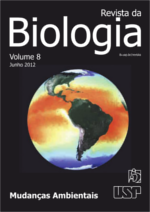Microbiota, secreções cutâneas e microclima: consequências para os anfíbios
DOI:
https://doi.org/10.11606/issn.1984-5154.v8p45-48Palavras-chave:
Anfíbios, microclima, microbiota, secreções cutâneas.Resumo
O significado das mudanças climáticas para os anfíbios, em sinergismo com outros impactos antropogênicos, está atrelado às possíveis mudanças dos microclimas nos habitats ocupados. Nesse contexto, os eventos de epidemias merecem destaque, uma vez que, é provável que as modificações no meio ambiente contribuam para a crescente disseminação de doenças. A primeira proteção dos anfíbios contra muitas doenças é a pele, junto com as suas secreções e microbiota, e são primordiais porque muitos dos agentes infecciosos envolvidos atuam nesse tecido. As principais barreiras são a microbiota residente e as secreções cutâneas, que possuem efeito antibiótico contra organismos patogênicos conhecidos. O ambiente modula as características inerentes a esses componentes, e por meio desses, mudanças nos padrões microclimáticos poderiam determinar os níveis de vulnerabilidade das populações de anfíbios aos patógenos.Downloads
Os dados de download ainda não estão disponíveis.
Downloads
Publicado
2018-04-23
Edição
Seção
Revisão
Licença
Salientamos que nossa revista não detém copyright, estes são exclusivos do autor do texto. Pretendemos com isso não criar entraves ao acesso do material publicado e atingir com mais intensidade nosso objetivo de divulgação da ciência.
Como Citar
Assis, A. B. de. (2018). Microbiota, secreções cutâneas e microclima: consequências para os anfíbios. Revista Da Biologia, 8(1), 45-48. https://doi.org/10.11606/issn.1984-5154.v8p45-48








 revistadabiologia@ib.usp.br
revistadabiologia@ib.usp.br 2008 - 2024 Revista da Biologia
2008 - 2024 Revista da Biologia